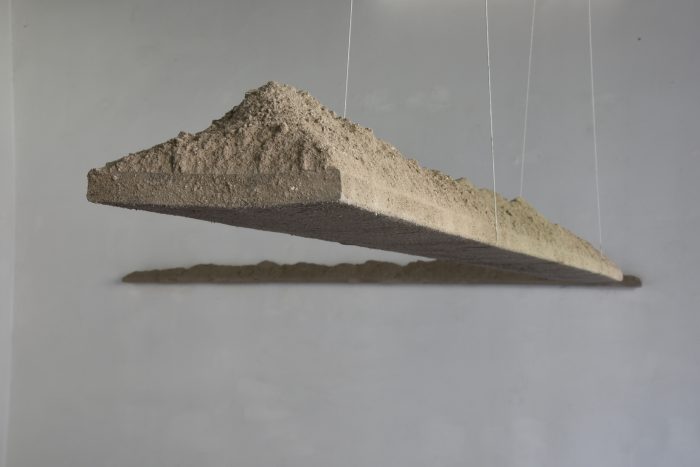
Ewa Kulesza: „Światłoczułość”Ewa Kulesza: "Photosensitivity of Ash"
Ewa Kulesza: „Światłoczułość”
10.01–01.03.2020
otwarcie wystawy: 10.01.2020 (piątek), godz. 18.00 / wstęp wolny
Mikroświat wystawy Ewy Kuleszy „Światłoczułość” w Galerii Sztuki Wozownia w Toruniu rozgrywa się w gamach szarości, wybrzmiewając subtelnie w przestrzeni swoją spopieloną obecnością. Szarość to barwa popiołu, popiół to zaś zetlała materia, którą w każdej chwili może rozwiać wiatr – ponieść, rozdmuchać, rozpylić... Popiół jest ulotny, kruchy, delikatny; wtapia się w tło swoją kolorystyką, a jednocześnie wydaje się tak natarczywie, intensywnie obecny. Jego sproszkowana, pełna potencjalnej lekkości substancjalność, na której tak łatwo zostawić odcisk czy ślad dotyku, nosi w sobie pamięć minionej kondycji i energię spalonych przedmiotów. Podległ transsubstancjacji, w ramach której przemienił się w proch, a więc stał się zwizualizowaną metaforą przemijania oraz procesu przejścia od bytu do niebytu. Paradoks polega jednak na tym, że ów niebyt wciąż ma materialny wymiar, którego ślady tak trudno usunąć z palców, gdy rozetrze się popiół między palcami i pozwoli mu wniknąć w meandry linii papilarnych.
Zespół obiektów, z których większość Ewa Kulesza przygotowała specjalnie na wystawę w Wozowni, buduje w przestrzeni galerii niespieszną, kontemplacyjną, a nawet medytacyjną narrację o poetyckim wydźwięku. To szara strefa, wewnątrz której inicjowana jest światłoczułość. Owa czułość budzi się w nas w stosunku do nas samych, gdy zaczynamy wyczuwać, że nasze ciała również spotka nieuchronny los, polegający na tym, że z czasem wtopimy się miękko w spopieloną szarość. Osypiemy się, a nasze – tak kiedyś żywe – pamięć i obecność pozostawią po sobie jedynie subtelne ślady: zarys domu, w którym mieszkaliśmy; wnętrza pudełek, w których tyle przechowywaliśmy; archiwa, w jakich pieczołowicie gromadziliśmy to, co (pozornie?) ważne.
Kiedy mam pisać o sztuce Ewy Kuleszy, zawsze mierzę się z obawą popadnięcia w sentymentalizm i poetyckość opisu. Pisząc ten tekst, znowu ulegam tej pokusie – pozwalam się uwieść strefie szarości i w wyobraźni dmucham w popiół, wzbijając w powietrze jego duszącą chmurę. Wdycham ją głęboko, somatyzując w sobie tę wyciszoną opowieść, która – paradoksalnie – wyjątkowo dobrze współgra z rozpędzonym, głośnym światem, pozbawionym światłoczułości. (tekst: Marta Smolińska)
Ewa Kulesza – studiowała fotografię oraz rzeźbę na Akademii Sztuk Pięknych w Poznaniu. Była stypendystką Ministerstwa Kultury i Sztuki oraz stypendium Miasta Poznania, rezydentka NKD Dale w Norwegii. Od 2004 roku pracuje na Uniwersytecie Artystycznym w Poznaniu. Zajmuje się książką artystyczną, instalacją, rzeźbą i fotografią. Wystawiała swoje prace na kilkudziesięciu wystawach indywidualnych i zbiorowych w Polsce, Niemczech, Szwajcarii, Słowacji, Portugalii, Japonii i Norwegii.
Wystawa zrealizowana przy wsparciu Wydziału Malarstwa i Rysunku UAP (projekt badawczy dofinansowany ze środków Ministerstwa Nauki i Szkolnictwa Wyższego w roku 2019)

Ewa Kulesza: "Photosensitivity of Ash"
exhibition opening: 10.01.2020 (Friday), 6 p.m. / free admission
exhibition open until 01.03.2020
Galeria Sztuki Wozownia, 6 Ducha Świętego street
The micro-world of Ewa Kulesza's "Photosensitivity" exhibition at the Wozownia Art Gallery in Toruń is set within a grey palette, resounding subtly in space with its ashen presence. Greyness is the colour of ash, the worn and ground matter, which can be blown away at any time by the wind. It can be carried off, spewed or sprayed to create a greyish cloud in the air... Ash is fleeting, fragile, tender, and weightless; its colours help it blend into the background and at the same time make it insistently and intensely present. Its powdered substance, full of potential lightness, where it is so easy to leave a print or a sign of a touch, preserves the memory of the past status and energy of burnt objects. Subjected to transubstantiation, it has been transformed into powder. It has become a visual metaphor of passing and the process of transition from being to non-existence. Paradoxically, however, this non-existence is still material and tangible; its traces are so difficult to remove from your fingers, when this ash gets between them and penetrates the meandering lines of your fingerprints. Jacques Derrida described it as a paradigm of trace; it is therefore a remainder, a remnant of something and at the same time it can no longer be what it originally was. It becomes a repository of metaphorical meanings which punctures and penetrates the memories of each viewer in a unique way. It has a heterogeneous nature, because it has recorded or imprinted time, or rather many different times and human experiences.
Traditional art history often separates meaning from material, even though in the 20th century materials were emancipated quite clearly as significant substances.[1] However, the linguistic interpretation of works of art as texts continues to dominate, which does not take sufficient account of their materiality and makes the non-material idea more important than its material dimension. Constantly subject to Hegel, we celebrate a work of art that has overcome and surpassed its own materiality. The materiality of Ewa Kulesza's objects, made with the use of ash, is so strong that it cannot be dismissed by a mere focus on their intangible message or by a question about what has been revealed. Ashes re-materialise works, which is also reflected here in my language of their interpretation, which includes sensitivity to things, materials and processes, and the materials themselves are seen as active agents in the process of artistic creation.[2] Moreover, Ewa Kulesza's ash is perfectly smooth and "pure", without lumps, without combustion residues and without "foreign" bodies. It is an ideal, exemplary and model ash that rarely exists in nature, but it perfectly fits into the field of art as it is not marked by any concreteness. It immediately becomes a universal metaphor.
Ewa Kulesza deals with everyday and temporal matters, embodied in greyed-out family photographs, intimate records, outlines of a house that have become weightless and risen above the ground, walls made of ash bricks or boxes of all shapes and sizes in which we collect and store so much... The artist makes us believe in the presence of these common phenomena , creating them from ash and confronting the viewers with the metaphor of afterlife. This time, the notion does not refer to life online, but has a (non)material dimension which makes use of the semantic potential of ash; born as a result of incineration, ash begins its life after life. It can also assume an organic, “fluid” form, as in the “Patch”, which spreads thanks to the combination of ash and water. It is like l’informe – something shapeless and amorphous, described by Georges Bataille, and thus causing a tremor in the fixed categories of perception shaped in relation to regular objects. It oozes and flows like lava; it freezes and bursts like dried earth, connoting the process inscribed in the ash. However, combining it with water is also a denial of its internal memory connected with fire and heat - in Ewa Kulesza's artistic strategy it becomes a gesture initiating another transformation of this matter, which fertilises the ground. The "Patch" - shapeless and arbitrary - appropriates space, helping to visualise yet another potential condition of ash as matter that constantly circulates in nature. As soon as it "hydrates", it returns to circulation and enters the cyclical life of ecosystems, of which man is an inseparable part.
"Background" is equally grey and ashen. Here the ash, evenly distributed and glued to the canvas, has an extremely unstable surface which is sensitive to the touch. Ewa Kulesza focused her total attention on it, making it the main theme and motif of one of her works: she subversively reversed the hierarchy, turning something marginal into a central element and moving the parergon to the position of the proper ergon. When photographs or paintings are lacking in posing figures, the viewers’ gazes must focus on what conventionally, with the use of models, would evade attention as something marginal, additional and forming a background. The last, while extremely significant, “hides” and falls back on itself, contributing to the visibility of the heroes of the foreground. The role of the background is to frame and highlight the outlines or objects standing before it, or to create a specific mood. Ewa Kulesza stresses this kind of visual absurdity, linked to the inner void that awaits the appearance of posing figures; the audience of the artist’s exhibition at Wozownia Art Gallery may become such figures. In traditional painting and photography we usually deal with a classical and comprehensible division into the figure and the background, and the hierarchy of the elements is clear. The background occupies a subordinate position. It serves as a parergon and is like a passe-partout with respect to the work proper. Besides, the mutual, hierarchic relation of the figure(s) and the background makes up a kind of whole; thus, the background itself can be perceived as a consequence of cultural habits, as a missing fragment that calls for complementation. Ewa Kulesza presents the background from ash, which assumes the role of the background not only of the whole exhibition, but also becomes a metaphor of the existential background on which a fragile spectacle of life takes place. The viewer is confronted not only with the lack of a figure, but also with the ostentatious presence of the background itself, which unexpectedly comes to the fore and stimulates a chain of associations connected with the fact that existence is a cyclic circulation of matter: from living matter to ash and back.
The artist imparts a number of multifaceted meanings to ash as the signature matter of her art. Definitely, the range of meanings transcends Christian symbolism. Ash becomes concreteness which, as Jolanta Brach-Czainy shows, one uniquely deals with and reads its “stories” told in the colour grey. It plays the role of an actor, which not only co-creates the message of the work, but also significantly generates it.
Photosensitivity
Does ash have light in it? - Yes, says Ewa Kulesza in the self-commentary on her own work. Although it is subdued, "deaf" in its greyness, completely opaque and dense, it also carries the memory of the fire that was the cause of its creation. The energy of this transformation, of the incineration process, is recorded in it; it will never be completely "extinguished" and dead as matter. It is a substance that immediately enters the role of a metaphor of memory, because it has in itself the memory of its own transformation into grey powder, made by the luminous flames. It solidifies in some concrete form, but it can fall apart even under the most delicate touch of fingers. It "glows" with an inner story that each viewer reads in it, depending on what has already been incinerated in their lives. Moreover, the flashing light in the exhibition space reacts to the presence of the audience and their dynamic movements. It also suddenly illuminates the grey ashen objects and temporarily dazzles and disorientates the viewers as if it were testing the limits of their sensitivity, treating them as if they were a sheet of photographic paper.
Photosensitivity
A group of objects, most of which were prepared by Ewa Kulesza specifically for the exhibition at Wozownia, make up a slow, poetic, contemplative and even meditative narrative in the gallery space. This grey zone initiates photosensitivity within. This tenderness awakens in us towards ourselves when we begin to feel that our bodies will also meet the inevitable fate, i.e. with time we will blend softly into the ashen greyness. We will crumble and what once was so vivid in our memory and presence will leave only subtle traces: the outline of the house we lived in, the interiors of the boxes in which we kept so much, the archives in which we meticulously gathered what was (seemingly?) important. Ash makes us aware of the unbearable lightness of being. It has both the weight of the biblical metaphor and the ephemerality that allows it to dance in the wind and dissolve into oblivion. It is also kind of abject because it unseals the cohesion of our identity, showing us - on the basis of our relationship with the matter of our bodies - how close we are to the grey substance that fertilises the earth.
***
When I am to write about Ewa Kulesza's art, I fear becoming sentimental and poetic in my description. Writing this text, I succumbed to this temptation again - I let myself be seduced by the zone of greyness and in my imagination, I blew into the ash, raising its suffocating cloud into the air. I inhaled it deeply, somatising in myself this calm story, which - paradoxically - interacts exceptionally well with the hectic, clamorous world, stripped of any photosensitivity.
Marta Smolińska
[1] A.-S. Lehmann, “The matter of the medium: some tools for an art theoretical interpretations of materials”, [in:] The Matter of Art: Material, Practices, Cultural Logics, c. 1250-1750, ed. C. Anderson, A. Dunlop, P. H. Smith, Manchester 2015, p. 22.
[2] A.-S. Lehmann, op. cit., p. 26. See also the theory of actor-network: B. Latour, Splatając na nowo to, co społeczne. Wprowadzenie do teorii aktora-sieci, transl. A. Derra, K. Abriszewski, Kraków 2010.
Źródło: Galeria Sztuki Wozownia



 DOJAZD
DOJAZD UDOSTĘPNIJ
UDOSTĘPNIJ
